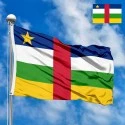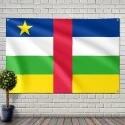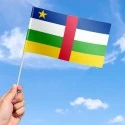The national flag of the Central African Republic (CAR) is a vibrant and deeply symbolic emblem that encapsulates the nation's aspirations, historical connections, and geographical position. Adopted on December 1, 1958, two years before the country gained full independence from France, this flag was designed by Barthélemy Boganda, the first president of the autonomous territory of Ubangi-Shari and a pivotal figure in the nation's journey towards self-determination. Boganda envisioned a flag that would transcend individual communities and unite the people of the CAR, while also symbolizing a bridge between Africa and Europe.
Design and Symbolism: A Tapestry of Colors
The flag is composed of four horizontal stripes of blue, white, green, and yellow, intersected by a vertical red stripe at its center. A yellow five-pointed star is placed in the upper hoist canton, slightly overlapping the blue and red stripes. This unique arrangement is not merely aesthetic; each element carries profound meaning.
-
Blue Stripe: Situated at the top, the blue stripe represents the sky, freedom, and the vastness of the Atlantic Ocean, symbolizing the nation's connection to the wider world and its aspirations for peace and progress. It also signifies the European continent, especially France, acknowledging the historical ties while looking forward to a new era.
-
White Stripe: Below the blue, the white stripe symbolizes purity, dignity, and the future of the nation. It represents the peace that the Central African people strive for and the honest work they commit to building their country. Like the blue, it also points towards the European influence, particularly through the concept of peace and democratic ideals.
-
Green Stripe: The third horizontal stripe, green, embodies the lush forests and rich agricultural resources of the Central African Republic. It speaks to the nation's natural wealth and the hope for prosperity derived from its land. Crucially, the green also represents the African continent, its vibrant peoples, and the collective struggle for independence and unity.
-
Yellow Stripe: The lowest horizontal stripe, yellow, signifies the savannahs, the sun, and the generosity of the people. It evokes the warmth, hospitality, and boundless energy of the Central African population. It also represents the gold, a valuable resource, and the potential for economic development.
-
Red Vertical Stripe: Cutting across all horizontal stripes, the bold red vertical stripe is perhaps the most powerful symbol on the flag. It represents the blood shed by the people of the Central African Republic in their struggle for independence and self-determination. It is a testament to the sacrifices made by their ancestors and a reminder of the nation's resilience and determination. More broadly, it symbolizes the bond of blood that unites all peoples, emphasizing the interconnectedness of humanity.
-
Yellow Five-Pointed Star: Positioned in the upper hoist corner, the yellow star is a beacon of hope, a guiding light for the future of the nation. It symbolizes independence, the shining future, and the leadership of the Central African Republic. Some interpretations also suggest it represents the unification of the peoples of the Central African states, pointing towards a larger Pan-African vision.
Dimensions and Proportions:
While specific official dimensions are often defined by law, the flag is typically displayed with a common aspect ratio of 2:3 or 3:5, similar to many national flags. The precise width of each stripe is proportional, ensuring the visual balance of the design. The central red stripe has the same width as the horizontal stripes, creating a strong, unifying visual element.
History and Evolution: A Nation's Journey to Self-Determination
The genesis of the Central African Republic's flag is inextricably linked to the country's political evolution from a French colony to an independent nation. Before its adoption, the territory of Ubangi-Shari, as it was then known, flew the French Tricolour.
Barthélemy Boganda, a visionary leader and nationalist, played a crucial role in the design. He founded the Mouvement pour l'évolution sociale de l'Afrique noire (MESAN – Movement for the Social Evolution of Black Africa) in 1949, which became the dominant political force. Boganda believed in the concept of a United States of Latin Africa, an ambitious federation that would unite former French, Belgian, and Portuguese colonies in Africa. The flag he designed for the Central African Republic was intended to serve as a prototype for this larger pan-African entity.
The flag was officially adopted on December 1, 1958, when the Central African Republic became an autonomous territory within the French Community. It was retained without alteration upon the country's full independence on August 13, 1960. This continuity underscored the stability and vision of the nascent nation. Despite numerous political upheavals, coups, and changes in leadership since independence, the flag has remained a constant symbol of national identity, a testament to its enduring significance and the foresight of its designer.
Regional Context and Pan-Africanism:
The Central African Republic is situated in the heart of Africa, a landlocked nation bordering Chad, Sudan, South Sudan, the Democratic Republic of Congo, and Cameroon. Its flag, with its strong Pan-African symbolism (green and yellow for Africa, red for unity/blood), reflects the broader aspirations of many newly independent African nations in the mid-20th century. Boganda's vision of a "United States of Latin Africa" resonated with the pan-Africanist movement, which sought to foster unity and solidarity among African peoples. The flag, therefore, is not just a symbol for the CAR but also a subtle nod to a larger, unifying African identity.
Significance for the Inhabitants: A Beacon of Identity and Resilience
For the people of the Central African Republic, the national flag is far more than a piece of cloth. It is a powerful embodiment of their history, struggles, and hopes. It represents their sovereignty, their hard-won independence, and their collective aspirations for a peaceful and prosperous future.
In a country that has faced significant challenges, including political instability, conflicts, and humanitarian crises, the flag serves as a unifying symbol. It reminds citizens of their shared heritage and their common destiny. During national celebrations, sporting events, and official ceremonies, the flag is displayed with pride, evoking a sense of patriotism and national unity. It is a visual testament to the resilience of the Central African people and their enduring spirit in the face of adversity. The colours and the star narrate a story of aspiration for freedom, peace, and prosperity rooted in African identity, while acknowledging historical ties and a global outlook. It is a constant reminder of the sacrifices made and the vision for a brighter tomorrow.
In the demonstration images, full-size flags are shown with proportions of 2:3, and hand-held flags with proportions of 1:2.






 Waving flag
Waving flag
 Sizes:
Sizes:
 Round flag
Round flag
 Sizes:
Sizes:
 Rectangular flag 2:3
Rectangular flag 2:3
 Sizes:
Sizes: